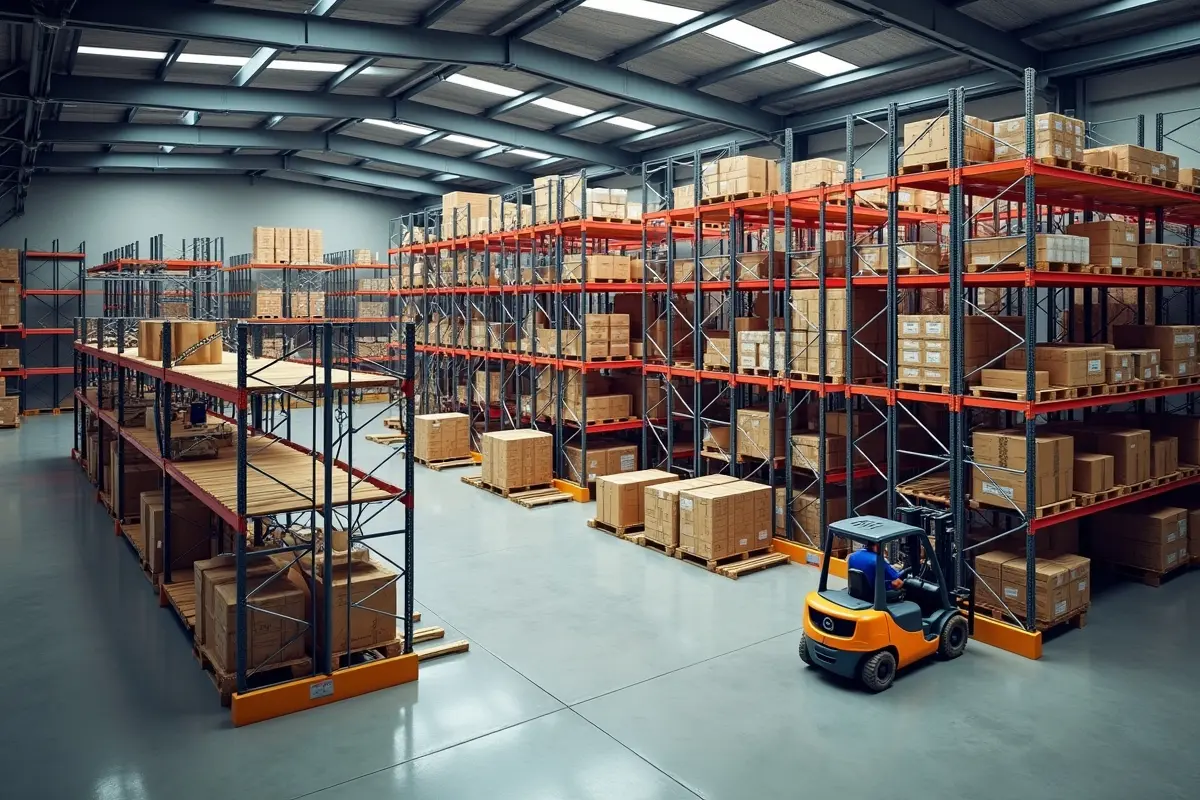
Pallet Racking Types and Their Ideal Uses in Industry
When it comes to organising industrial spaces, pallet racking is one of the most efficient solutions. If you’re managing a warehouse or supply chain operation, having the right pallet racking system can make all the difference in how smoothly everything runs. But with so many types of pallet racking out there, how do you know which one suits your needs?
Contents
- 1 What Is Pallet Racking, and Why Is It Essential?
- 2 Selective Pallet Racking – Maximum Accessibility
- 3 Drive-In and Drive-Through Racking – High-Density Storage
- 4 Push-Back Racking – Easy Access Meets High Density
- 5 Pallet Flow Racking – Streamlined FIFO Storage
- 6 Cantilever Racking – Perfect for Long, Bulky Items
- 7 Narrow Aisle Racking – The Space-Saving Specialist
- 8 Factors to Consider When Choosing a System
- 9 Keeping Safety Front and Centre
- 10 Which Racking System Is Right for You?
What Is Pallet Racking, and Why Is It Essential?
Pallet racking is a storage system designed to hold materials on pallets in a way that maximises space and improves access. It allows you to store goods vertically, which is far more efficient than traditional storage methods.
Beyond just saving space, the right pallet racking system ensures your workflow is seamless. Whether you need quick access to high-demand items or are storing products long-term, with the different types of pallet racking available, you’re bound to find the perfect solution for your needs.
Selective Pallet Racking – Maximum Accessibility
If you need a system that offers direct access to every pallet, selective pallet racking is your go-to. This is the most common type of racking found in warehouses because of its flexibility and simplicity. It’s perfect for industries where you frequently need to retrieve specific items.
The major advantage? It’s highly customisable. You can adjust the beams to accommodate pallets of different sizes. However, it may not be the best option if your priority is maximising storage density, as it requires wide aisles to access each pallet. Think of it as the jack-of-all-trades—ideal for operations with varied inventory.
Drive-In and Drive-Through Racking – High-Density Storage
When storage space is at a premium, drive-in and drive-through racking are excellent options. These systems eliminate the need for aisles, allowing forklifts to enter the racking structure itself to load or retrieve pallets.
- Drive-In Racking works on a last-in, first-out (LIFO) principle, where the last pallet stored is the first one removed. It’s ideal for products that don’t require frequent rotation.
- Drive-Through Racking, on the other hand, operates on a first-in, first-out (FIFO) basis. You load pallets from one end and remove them from the other, making it perfect for items with a shorter shelf life.
Both types are particularly useful in industries like food and beverage, where space efficiency is key and high volumes of similar products are stored.
Push-Back Racking – Easy Access Meets High Density
Do you need a solution that balances storage density with accessibility? Push-back racking is worth considering. This system uses inclined rails to store pallets on a slight slope. When you load a new pallet, it pushes the previous one back. When unloading, the pallets naturally slide forward.
It’s perfect for operations requiring a LIFO setup. Think retail or manufacturing industries where you store similar products and need a system that maximises space without sacrificing ease of use.
Pallet Flow Racking – Streamlined FIFO Storage
For industries that need to move products quickly, such as pharmaceuticals or food distribution, pallet flow racking is a game-changer. This system uses rollers or wheels to allow pallets to glide forward automatically. It’s built for FIFO storage, ensuring older stock is always used first.
Pallet flow racking is particularly effective for high-volume operations. While it requires a higher upfront investment, the efficiency gains can easily justify the cost over time. If your focus is on speed and inventory rotation, this might be the ideal fit for your needs.
Cantilever Racking – Perfect for Long, Bulky Items
Not every product fits neatly on a pallet. Cantilever racking is designed for items like timber, pipes, or steel beams that are long and awkward to store. Instead of traditional shelving, it uses horizontal arms that extend outward, making it easy to store and retrieve oversized goods.
This type of racking is particularly common in construction and manufacturing industries. It offers unmatched flexibility and ensures you’re not wasting space trying to fit square pegs into round holes—so to speak.
Narrow Aisle Racking – The Space-Saving Specialist
Do you need to squeeze every last centimetre out of your warehouse? Narrow aisle racking is designed to do just that. By reducing the aisle width required for forklifts, you can significantly increase your storage capacity.
This system pairs well with specialised forklifts, such as turret trucks, which can operate in tighter spaces. It’s perfect for industries where storage density is critical, like e-commerce or distribution centres with large inventories.
Factors to Consider When Choosing a System
Now that you know the types of pallet racking, how do you choose the right one? It all comes down to your specific needs. Start by asking yourself:
- What type of inventory do you store? Perishable goods need a FIFO system, while long-term storage might benefit from a LIFO setup.
- How much space do you have? High-density options like drive-in racking might be better for compact warehouses.
- What’s your budget? Some systems, like selective racking, are more cost-effective upfront, while others, like pallet flow racking, offer long-term savings through improved efficiency.
- How often do you access your inventory? If frequent retrieval is part of your daily workflow, accessibility should be a top priority.
Once you have these answers, it’ll be easier to narrow down your options.
Keeping Safety Front and Centre
No matter what type of racking system you choose, safety should always be a priority. Regular inspections, proper weight limits, and ensuring your employees are trained to operate forklifts in the system are non-negotiable. A well-maintained racking system not only protects your inventory but also keeps your team safe.
Which Racking System Is Right for You?
Every operation is different, and the best pallet racking system for your business depends on your unique needs. Whether you’re aiming to maximise space, improve accessibility, or streamline your workflow, there’s a solution out there to fit the bill. Take the time to evaluate your inventory, warehouse layout, and operational goals. Investing in the right racking system now can pay dividends in efficiency and productivity for years to come.


